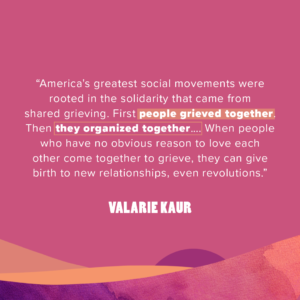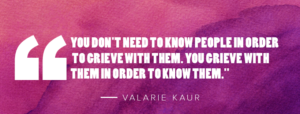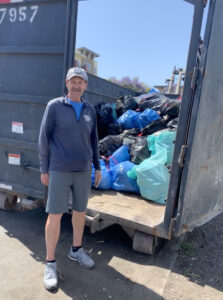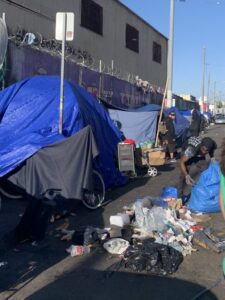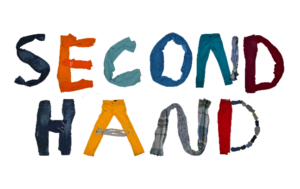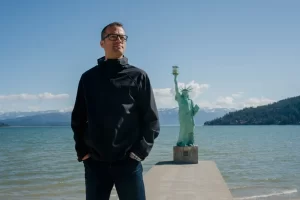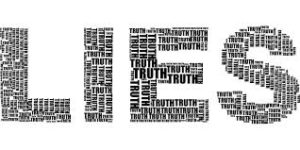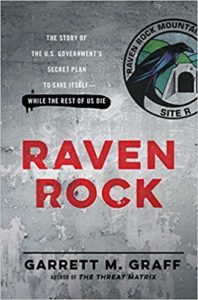White Supremacy
Saturday, May 21, 2022
May 21, 2022To solve humanity’s problems, we need well-functioning brains…eating and living well with kindness and awareness…always compassion…building our brain architecture.
Tending body is tending to the self, and tending to the self is tending community, tending community is tending country.
[On Being]
J
O
Y
“The joy of life is to put out one’s power in some natural and useful or harmless way.”
-Oliver Wendell Holmes
Valerie Kaur
Oh my loves.
“They’re going to keep killing us.” This was my first thought after the news broke about the shooting at a grocery store in Buffalo. Terror and fatigue.
I’ve organized around white supremacist hate for 21 years, since before this gunman was born. The killings have become more frequent, more effective, and more efficient at taking life. I got the news while working on a memorial video on the white supremacist mass shooting in Oak Creek 10 years ago, revisiting all that pain. How to feel fresh grief when we are already in grief? How does the heart expand, instead of shut down?
Revolutionary love is the choice to labor for others, opponents, and ourselves. What is your role right now?
Will you focus on others? Grieve with Black people, show up to local vigils and gatherings, listen to the stories, fight for anti-racist policies, build new relationships of solidarity. Do one thing in your sphere of influence — your school, workplace, house of worship, or home — to stand in love.
Will you focus on opponents? The gunman cited “replacement theory” in his manifesto, a theory that nearly one in three Americans believe. Reach out to the colleagues, neighbors, relatives in your life who subscribe to this dangerous and racist belief. Open a channel for deep listening, share stories, stop the spread of misinformation.
Will you focus on your body and your people? If you can feel how this shooting touches trauma in yourself and in people you love, this is the time to make space for healing. Grieve and rage, wail and scream, rest and breathe. Be with people who make you feel safe. Let in softness and love into the places that ache. Together, we survive this. {And what is yet inevitably to come. -dayle}
[1,000,000 + have died from COVID. 1 in 3 U.S. citizens believe the plague has ended. It has not.]
More from Valerie:
Where do you notice feeling grief in your body? What is the quality of that grief? What is the shape of grief inside of you? If it feels uncomfortable, take another deep breath and stay with it. Breathe through it.
What does your body need to be brave with this grief? What do you need to feel it and to move through this energy? What rituals are you called to? Who do you need by your side.
Who have you not yet grieved with? Whose story have you not fully let into your heart? What community’s struggle have you not fully taken in? Notice what is happening in your body. If your fists tighten, or your heart beats fast, or if shame rises to your face, it’s okay. Breathe through it. Trust that you can. The heart is a muscle: The more you use it, the stronger it becomes. You don’t need to know people in order to grieve with them. You grieve with them in order to know them.
What do you need to do to be able to grieve with them? What vigils or marches need you? What houses of worship are you ready to visit? What phone call are you ready to make? You can begin where you are, with a simple text or email, saying to someone “I’m here for you.”
How to be brave with your grief.
https://valariekaur.com/2022/04/how-to-be-brave-with-your-grief/
“Loving someone means that one day, there will be grieving. They will leave you, or you will leave them. The more you love, the more you grieve. And so I invite you to honor your grief: it’s a sign of how deeply you have loved.”
-Valerie
Community, then country.
Coronado Times
Meet Brian Trotier
Triangle Project, located in the East Village of San Diego, just across the bay.
“The Triangle Project is a pilot program created to help improve the lives of unhoused people. Brian has been helping out in this area for about fifteen years and has developed relationships with many of the residents. A huge issue has been the trash in the area. The residents, mainly living in tents, don’t have a place to dispose of their trash which is unsightly, unsanitary, and demoralizing for them. Richard Aaron Horton, 64, a longtime resident, started improving the area by picking up trash. Brian Trotier knows Richard well and has expanded the effort by securing funding from the Lucky Duck Foundation. This local foundation focuses on the homeless and has contracted with EDCO for a dumpster to collect the trash.
The concept is simple, and the results so far have been amazing. Brian reported that, as of last week, the Triangle Project had collected in the previous 20 days, 3,794 bags of trash weighing a total of 23.89 tons. It is likely that much of this, including plastic, would have found its way into our bay and ocean. Here is how it works: every Monday and Thursday, EDCO drops off a dumpster at 8 am. Brian brings bags, gloves, and a stack of cash. Volunteers walk around the area greeting residents and asking if they’d like trash bags. For almost all, the answer is an enthusiastic “yes!” Residents get to work cleaning up their neighborhood. For every full bag of trash they bring to the dumpster, Brian gives them $2. The roughly two-block area goes from being very littered to being very clean within an hour.”
“riangle Project’s results are about double what Brian and Lucky Duck projected, and the benefits have gone far beyond a cleaner neighborhood (and bay). Residents express appreciation for being seen; they get along better with each other. “They have a common enemy—trash,” Brian acknowledged.”
“Keeping the Earth clean. That’s what’s happening in the long run. It’s a domino effect.”
https://coronadotimes.com/news/2022/05/18/meet-emerald-keeper-of-the-month-brian-trotier/
The Independent
My Carbon Footprint: the rise of the nearly new
by, Kate Hughes
“So often, being more eco is inaccurately pinned to greater cost, when actually – especially when it comes to everyday buying decisions – the opposite is true.
This widespread, if subtle shift in the way we shop, including the disintegration of the stigma around nearly new, vintage, and preloved may well have some relationship with the climate crisis but make no mistake, this is largely financially led.
What I love about second-hand too, is that it doesn’t preclude us from layering up further planet and cash-saving approaches.
When the old boy on our street moved into a retirement flat the neighbours bought his lawnmower off him. There’s now one lawnmower between five households, saving space, cash and helping maintain and develop lines of local communication and a sense of community.
More than four in 10 of us gave goods away for free locally in the first few months of the year, while half donated products to charity and more than a third even made financial donations despite experiencing hardship.
Free stuff – everything from haircuts to sofas are also on the rise, the site reports.
So go forth and embrace the charity shop, the quirky apps, the leviathan websites.”
HuffPost
Living With The Far-Right Insurgency In Idaho
A radical GOP faction, in open alliance with extremists, is seizing power and targeting its opponents with cruelty.
Some wonder: Is it time to leave? (Yes. It is.)
Jennifer Ellis, photographed in her home on April 3, 2022, created Take Back Idaho to push back against the right-wing, extremist views and tactics that have dominated the state’s politics.
‘A lot has been written about both the radicalization of the Republican Party and the decline of democracy in the U.S. — about the country being at a precipice. It’s maybe easy for those warnings to become background noise, or to dismiss them as doom-mongering pieces of clickbait. But in Idaho, the nightmare scenario is crossing into reality, as an authoritarian GOP sets about to create a whiter, Christian nation.
These MAGA radicals have gestured at the future they want: no rape and incest exceptions to Idaho’s abortion ban; no emergency contraception; no gender-affirming health care for minors; the banning of books; the jailing of librarians; and maybe no public education altogether.
I recently spent a week traveling across the state, from Sandpoint in the northern panhandle down through the green slopes and whitewater of Hell’s Canyon to the plains of Ada County, and then across lava rock and sagebrush to Blackfoot. In all these places, Democrats and more moderate Republicans view Tuesday’s primaries as an existential affair. Some are considering leaving the state if MAGA extremists consolidate more power. Others are digging in their heels.
The people I talked to were not all that accustomed to alarmism, which made it striking to hear some of their voices tremble when they talked about what’s happening to their home. Their message for the rest of the country? It’s gonna get bad. The GOP really will go that far.
“They have completely rebranded what it is to be a conservative here in north Idaho, and they have literally excommunicated and cleaned house of any rational, regular conservative from their ranks.”
– Shawn Keenan, local Democratic activist
“As much as I want to point to examples of their adverse impact on the legislative process — and there’s many things to point to — part of me, the social scientist in me, the military veteran in me, wants to, you know, not just hate the player, but hate the game,” said Mathias, who served in the Coast Guard and has a Ph.D. in public policy.
A grading system like the Freedom Index makes the often inscrutable process of legislating more accessible to voters, Mathias said, and the IFF is an outrageous arbiter.
Mathias is intimately familiar with the group. Last spring, he watched state Rep. Ron Nate (FI Score: 97%) and other far-right legislators manufacture a racist moral panic about Boise State University indoctrinating students with “critical race theory.” (It was not.) Nate, using talking points lifted from an IFF white paper, argued for cutting part of the school’s budget.
Mathias says he typically likes to “keep his powder dry” in the statehouse — Democrats are such a minority there, it’s not worth the fuss to debate every proposal — but in this case, both as the only Black man in the legislature and as a Boise State alumni, he felt compelled to speak.
Going to Boise State on the GI Bill, he told his colleagues in a speech on the House floor, pausing to fight back his emotions, “provided opportunities I’d never seen in my life. It changed my life.”
Critical race theory, he continued, simply recognizes that there are institutional biases — in “housing, health, education, wealth, income,” Mathias said — that have existed since our country was founded. “People of color always come out on the losing end,” he added, his voice breaking. “Always. And I don’t think it’s unfair to acknowledge it.”
Across Idaho, the far right has laid siege to nonpartisan positions, some of which require specific expertise, and made them partisan, installing loyalists with sometimes disastrous results.
A recent Vanity Fair piece, for example, profiled members of the national neoreactionary movement, acolytes of a philosopher named Curtis Yarvin, who is a close ally of billionaire Peter Thiel. This movement, which has buy-in from powerful GOP figures, is explicit about wanting to usher in the end of democracy by purging the current government of its enemies and establishing one-party control — or, put another way, authoritarianism.
J.D. Vance — the venture capitalist and “Hillbilly Elegy” author who recently won the Ohio Republican primary for U.S. Senate — is a follower of Yarvin’s. He positively likened this prospective purge to the deadly “de-Baathification of Iraq.”
“I think Trump is going to run again in 2024,” Vance told Vanity Fair. “I think that what Trump should do, if I was giving him one piece of advice: Fire every single mid-level bureaucrat, every civil servant in the administrative state, replace them with our people.”
Vance and Trump might look to north Idaho for inspiration.
“We’re losing here. We’re losing our state. We’re losing our town. … It’s just becoming overwhelming.”
– Sandpoint Mayor Shelby Rognstad
Full report:
https://www.huffpost.com/entry/far-right-idaho_n_628277e2e4b0c84db7282bd6/amp
X2
January 13, 2021Time to put on your big boy pants, Mitch.
232-197
“No president has ever had so many members of their own party vote to impeach them.”
-Young journalist Gabe Fleisher
https://www.wakeuptopolitics.com
From an overnight streaming post on social media from Rep. Alexandria Ocasio-Cortez, speaking to the nihilism of white supremacist violence:
“What claim will you have? That you rule over a destroyed society? That the ashes belong to you?”
‘When black people and their allies exercise freedom of speech, it is called violent insurrection. When white racists carry out violent insurrection, it is called free speech.’
Members of the National Guard rest below the iconic painting of our first president, on the day Congress impeached the 45th.
And the headline we never got to see.
Contemplation and Racism
June 8, 2020
Image credit: Red Azaleas Singing and Dancing Rock and Roll Music (detail), Alma Thomas, 1976, Smithsonian American Art Museum, bequest of the artist, 1980.36.2A-C, Washington, DC.
The Unspoken Privilege of Being White
For a long time, I naively hoped that racism was a thing of the past. Those of us who are white have a very hard time seeing that we constantly receive special treatment [because of social systems built to prioritize people with white skin]. This systemic “white privilege” makes it harder for us to recognize the experiences of people of color as valid and real when they speak of racial profiling, police brutality, discrimination in the workplace, continued segregation in schools, lack of access to housing, and on and on. This is not the experience of most white people, so how can it be true? Now, we are being shown how limited our vision is.
Because we have never been on the other side, we largely do not recognize the structural access we enjoy, the trust we think we deserve, the assumption that we always belong and do not have to earn our belonging. All this we take for granted as normal. Only the outsider can spot these attitudes in us.
[And we are quick to dismiss what is apparent to our neighbors who are Black, Indigenous, and People of Color [BIPOC] from their lived experience.]
Of course, we all belong. There is no issue of more or less in the eyes of an Infinite God. Yet the ego believes the lie that there isn’t enough to go around and that for me to succeed or win, someone else must lose. And so we’ve greedily supported systems and governments that work to our own advantage at the expense of others, most often people of color or any highly visible difference. The advancement of the white person was too often at the cost of other people not advancing at all. A minor history course should make that rather clear.
I would have never seen my own white privilege if I had not been forced outside of my dominant white culture by travel, by working in the jail, by hearing stories from counselees and, frankly, by making a complete fool of myself in so many social settings—most of which I had the freedom to avoid!
Power [and privilege] never surrenders without a fight. If your entire life has been to live unquestioned in your position of power—a power that was culturally given to you, but you think you earned—there is almost no way you will give it up without major failure, suffering, humiliation, or defeat. As long as we really want to be on top and would take advantage of any privilege or short cut to get us there, we will never experience true “liberty, equality, fraternity” (revolutionary ideals that endure as mottos for France and Haiti).
If God operates as me, God operates as “thee” too, and the playing field is utterly leveled forever. Like Jesus, Francis, Clare, and many other humble mystics, we then rush down instead of up. In the act of letting go and choosing to become servants, community can at last be possible. The illusory state of privilege just gets in the way of neighboring and basic human friendship.
-Fr. Richard Rohr, Center for Action & Contemplation
USA Today
100 ways you can take action against racism right now
If you’re looking to get involved outside of organizing in person, we’ve rounded up a list of ways you can take action from home, including ideas specific to demanding justice for Floyd and addressing racism in general.
[Also showing on Netflix.]
Previously unseen footage is shaped into a fresh and timely retelling of the 1992 Rodney King trial — and the verdict that sparked civil unrest–the acquittal of four police officers for beating a black motorist saw several days of protests, violence and looting in Los Angeles. Gives back story to the Watts Rebellion of 1965 in South-Central Los Angeles. Directed by T.J. Martin and Daniel Lindsay.
Seth Godin:
We can’t permit the murder of people because of the color of their skin. Institutional racism is real, it’s often invisible, and it’s pernicious.
And White Supremacy is a loaded term precisely because the systems and their terrible effects are very real, widespread and run deep.
The benefit of the doubt is powerful indeed, and that benefit has helped me and people like me for generations. I’m ashamed of how we got here, and want to more powerfully contribute and model how we can get better, together.
It doesn’t matter how many blog posts about justice I write, or how clear I try to be about the power of diversity in our organizations. Not if I’m leaving doubt about the scale and enormity of the suffering that people feel, not just themselves, but for their parents before them and for the kids that will follow them.
It’s easier to look away and to decide that this is a problem for someone else. It’s actually a problem for all of us. And problems have solutions and problems are uncomfortable.
Reality check.
June 23, 2018All the World is full of suffering. It is also full of overcoming. -Helen Keller
Much of our anxiety and inner turmoil comes from living in a global culture whose values drive us from the essence of what matters. -Mark Nepo
As spiritual beings, we have within us the inherent power to rise above any circumstance. -Rev. Jane Beach
NPR
David Folkenflick
‘When the White House Can’t Be Believed’
This essay isn’t about spin, or splitting hairs, or differing opinions.
This involves a reality check about our expectations of the people who act in our name. About credibility at the highest levels of our government. About people whose words are heard abroad as speaking for our nation. About the public and the media that try, however imperfectly, to serve it.
[…]
You could call what she [Homeland Security Secretary Kirstjen Nielsen] said a deception, an evasion or a technical nicety. NPR will not call what Nielsen said a lie because it cannot gauge her intent.
I report about the media for NPR and in so doing, I periodically cover NPR and its policies. I don’t speak for the network. I would say the word “lie” fits here.
[…]
But what you call it almost doesn’t matter.
More important is that the media and the public register a fundamental fact: Top people speaking for the United States aren’t telling us the truth — starting with the president.
https://www.npr.org/2018/06/20/621876079/when-the-white-house-cant-be-believed
Columbia Journalism Review
Advocates are becoming journalists. Is that a good thing?
As the media landscape continues to fragment and many outlets struggle to afford more ambitious reporting projects, non-governmental organizations and advocacy groups like the ACLU and Human Rights Watch are increasingly taking on the role of reporter—breaking stories and in some cases even helping to change policy. But even those leading the new NGO-as-muckraker efforts acknowledge that they’re no replacement for traditional news organizations.
The line between advocacy groups and media organizations has been blurring for some time.
Journalism professor Dan Gillmor wrote a decade ago about the work the ACLU was doing around Guantanamo Bay, and the reporting Human Rights Watch did on issues such as domestic workers in Saudi Arabia. A number of academics have also written about the increasing overlap between NGOs and journalism.
“As traditional journalism companies are firing reporters and editors right and left, the almost-journalist organizations have both the deep pockets and staffing to fill in some of the gaps,” Gillmor wrote. He also encouraged NGOs to concentrate on applying journalistic principles such as fact-checking and transparency.
Of course, traditional media organizations often get accused of distorting the news in similar ways—of selectively including certain facts or quoting certain individuals—because those facts or views fit a certain worldview. In some cases it’s done in order to generate traffic and advertising revenue, but there can also be ideological elements at work (Fox News, or at least the version of it that exists in primetime, springs to mind).
In the end, the world of journalism and the world as a whole are probably better off now that there are activist organizations that are trying to use the tools of modern media to tell stories. The more sources of information there are, especially from remote or developing nations, the better. In some ways, that’s one of the biggest benefits of a democratized media environment—anyone anywhere can become a news source, and that’s fundamentally a good thing, even if some take advantage of it for their own purposes.
d: At this moment in our democracy, we do indeed need moral thinkers serving as activists; both-sides journalism, and for-profit media prior and post the 2016 presidential primary, have delivered us to this point of massive deception and gaslit lies. Perhaps only journalists as activists, and ‘democratized media’ will deliver us from the deception and recurrent lies being generated from this nation’s highest offices.
Society of Professional Journalists
spj.org
Minimize Harm
Journalists should:
- Take responsibility for the accuracy of their work.
- Balance the public’s need for information against potential harm or discomfort.
- Show compassion for those who may be affected by news coverage.
The Intercept
All mass crimes in history start with a justification, a necessity rationalization, a sick form of nationalism and racism.
Administration of Hate: The Snatching and Caging of Immigrant Children. It is Happening Here.
This week on Intercepted: The Intercept’s Ryan Devereaux talks about his recent reporting in the border state of Arizona and paints a harrowing picture of the human toll of family separations by ICE. Alice Speri lays out her investigation of sexual abuse by ICE officers and contractors in immigration detention centers. Sohail Daulatzai discusses his new book, “With Stones in Our Hands: Writings on Muslims, Racism, and Empire,” and explains why the film “The Battle of Algiers” is still relevant more than 50 years after its release. The legendary resistance singer Barbara Dane shares stories from her 91 years on earth fighting militarism, racism, and economic injustice. Plus, Homeland Security Secretary Kirstjen Nielsen competes on Jeopardy! and we hear a cover of “The Partisan” from composers and musicians Leo Heiblum of Mexico and Tenzin Choegyal of Tibet.
NPR
James Doubek
White Civil Rights Rally Approved for D.C. in August
The National Park Service has approved an initial request for organizers to hold a second “Unite the Right” rally, this time across the street from the White House in August — one year after white supremacists gathered in Charlottesville, Va.
The park service has given initial approval to an application from Jason Kessler to hold a “white civil rights rally” on Aug. 11 and 12, as first reported by WUSA9. Kessler, along with white supremacist Richard Spencer and others, organized the 2017 rally, during which a woman was killed. The park service has not yet issued a permit for the event.
https://www.npr.org/2018/06/21/622144455/white-civil-rights-rally-approved-for-d-c-in-august
Think Progress
Meet the Favorite Philosophers of Young White Supremacists
A new book explores how philosophers like Nietzsche and Heidegger have inspired a new generation of fascists.
Casey Michel
As Donald Trump basked in his presidential election victory in 2016, white supremacist Richard Spencer unleashed a round of Nazi-inspired praise for Trump’s victory — sentiments echoed by Alexander Dugin, a Russian neo-fascist whose writings reached a broader-English-speaking audience thanks to Spencer and his wife, Nina Kouprianova.
These three, writes University of Toronto political science professor Ronald Beiner, all trace their fascistic views back to a pair of German philosophers: Friedrich Nietzsche and Martin Heidegger, both of whom played outsized roles in either inspiring
As Beiner writes in Dangerous Minds: Nietzsche, Heidegger, and the Return of the Far Right, the recent resurgence of the far-right and white supremacy didn’t occur in any kind of philosophical vacuum. Rather, it’s rooted in a long lineage of fascists who have leaned on Nietzsche and Heidegger to excuse and expand their own racism, anti-Semitism, and personal quests for power.
[…]
Decades later, the two philosophers have gained newfound prominence thanks to the growing impact of neo-fascists and white supremacists on both sides of the Atlantic. ThinkProgress spoke with Beiner about the effect Nietzsche and Heidegger have had, and what may come next for the young white supremacists who have found their philosophical heroes in a pair of German thinkers.
[…]
Nietzsche and Heidegger despise the Reformation, the Enlightenment, the French Revolution — they resolutely, deliberately, and bitterly reject that legacy, that inheritance of the modern West. I’d say they violently reject [them]. Why is that? Take the French Revolution. Really what it stands for is the idea that people should not be locked into pre-dictated roles in life, scripts they’re meant to live out. The idea is to give individuals space to map out their own ideas of life, to live freely. Well, Nietzsche totally rejects that.
[…]
The project is: destroy liberalism. Destroy the moral and political horizons of modernity. Destroy everything from the ground up. And if it takes a nuclear explosion and just starting all over again, they’re happy with it.
https://thinkprogress.org/this-philosophers-of-young-white-supremacists-33605ba538c0/?utm_campaign=trueAnthem:+Trending+Content&utm_content=5b2e8ab819694a00076e8a10&utm_medium=trueAnthem&utm_source=twitter
d: Then, if we really want to sober up, we read this:
In Raven Rock, Garrett Graff sheds light on the inner workings of the 650-acre compound (called Raven Rock) just miles from Camp David, as well as dozens of other bunkers the government built its top leaders during the Cold War, from the White House lawn to Cheyenne Mountain in Colorado to Palm Beach, Florida, and the secret plans that would have kicked in after a Cold War nuclear attack to round up foreigners and dissidents, and nationalize industries.
Equal parts a presidential, military, and political history, Raven Rock tracks the evolution of the government’s plans and the threats of global war from the dawn of the nuclear era through the present day. Relying upon thousands of pages of once-classified documents, as well as original interviews and visits to former and current COG facilities, Graff brings readers through the back channels of government to understand exactly what is at stake if our nation is attacked, and how we’re prepared to respond if it is. [Amazon]
—Walter Isaacson, author of Steve Jobs and Einstein:
Garrett Graff has given us a colorful and frightening account of the American government’s plans for doomsday, and the secret bunkers where official could go to save themselves. These early plans still have their counterparts today, and they reveal a lot about how warfighting doctrine evolved. Read it and be fascinated—and a little scared.”
Fresh Air’s Terry Gross interviewed Graff in 2017, and re-aired her interview on Friday, June 22nd. The book was just released in paperback.
Graff is a former editor of Washingtonian magazine and Politico Magazine. He also is a contributing writer to Wired magazine. Terry interviewed him last year when his book was published. It’s now out in paperback.
[excerpt]
Raven Rock is this massive, hollowed-out mountain. I mean, it’s a free-standing city inside, you know, with individual buildings – three-story buildings built inside of this mountain. And it has everything that a small city would. I mean, there’s a fire department there. There’s a police department, medical facilities, dining halls. The dining facility serves four meals a day. It’s a 24-hour facility. And it has been – it was sort of mothballed to a certain extent during the 1990s as the Cold War ended and then was restarted in a hurry after 9/11 and has been pretty dramatically expanded over the last 15 years and, you know, today could hold as many as 5,000 people in the event of an emergency.
GROSS: So you have these underground bunkers the size of cities in case of nuclear attack to protect members of government and keep the government going. You say that these places are staffed 24 hours a day, 365 days a year.
GRAFF: Yes. They are staffed 24 hours a day, 365 days a year. And it’s not just the bunkers. Right as we are sitting here talking today, there is a presidential doomsday plane, these converted 747s that are known as the Nightwatch planes. There are four of them. They’ve been in existence for the last quarter century. And one of them is sitting on a runway in Omaha, Neb., at Offutt Air Force Base right now. Its engines are on. It’s fully staffed with everyone that you would need to lead a nuclear war. And it’s ready to launch in a 15-minute alert in the event of an emergency and rendezvous with the president, wherever he may end up being, and evacuate him.
d: And then we remember who occupies the Oval Office.
#

